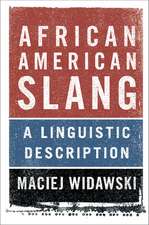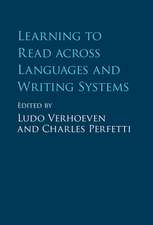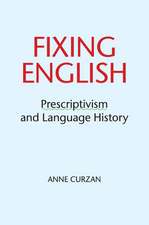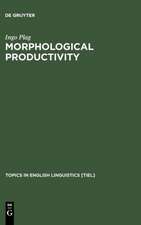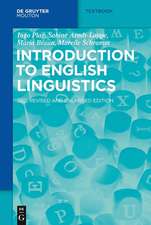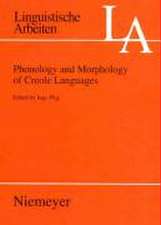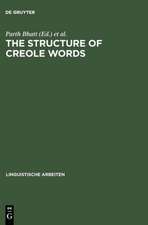Word-Formation in English: Cambridge Textbooks in Linguistics
Autor Ingo Plagen Limba Engleză Paperback – 11 iul 2018
| Toate formatele și edițiile | Preț | Express |
|---|---|---|
| Paperback (1) | 328.06 lei 6-8 săpt. | +47.27 lei 4-10 zile |
| Cambridge University Press – 11 iul 2018 | 328.06 lei 6-8 săpt. | +47.27 lei 4-10 zile |
| Hardback (1) | 593.46 lei 6-8 săpt. | |
| Cambridge University Press – 11 iul 2018 | 593.46 lei 6-8 săpt. |
Din seria Cambridge Textbooks in Linguistics
-
 Preț: 275.03 lei
Preț: 275.03 lei -
 Preț: 224.71 lei
Preț: 224.71 lei -
 Preț: 231.67 lei
Preț: 231.67 lei -
 Preț: 187.27 lei
Preț: 187.27 lei -
 Preț: 289.47 lei
Preț: 289.47 lei -
 Preț: 293.17 lei
Preț: 293.17 lei -
 Preț: 261.53 lei
Preț: 261.53 lei -
 Preț: 192.70 lei
Preț: 192.70 lei -
 Preț: 209.15 lei
Preț: 209.15 lei - 19%
 Preț: 438.05 lei
Preț: 438.05 lei - 11%
 Preț: 439.51 lei
Preț: 439.51 lei -
 Preț: 434.83 lei
Preț: 434.83 lei -
 Preț: 451.11 lei
Preț: 451.11 lei -
 Preț: 444.19 lei
Preț: 444.19 lei - 11%
 Preț: 462.43 lei
Preț: 462.43 lei -
 Preț: 444.19 lei
Preț: 444.19 lei - 11%
 Preț: 466.14 lei
Preț: 466.14 lei - 11%
 Preț: 466.82 lei
Preț: 466.82 lei -
 Preț: 443.70 lei
Preț: 443.70 lei - 11%
 Preț: 433.85 lei
Preț: 433.85 lei - 11%
 Preț: 605.27 lei
Preț: 605.27 lei - 11%
 Preț: 538.68 lei
Preț: 538.68 lei - 14%
 Preț: 765.01 lei
Preț: 765.01 lei -
 Preț: 453.98 lei
Preț: 453.98 lei -
 Preț: 465.99 lei
Preț: 465.99 lei -
 Preț: 443.60 lei
Preț: 443.60 lei -
 Preț: 462.01 lei
Preț: 462.01 lei - 11%
 Preț: 425.48 lei
Preț: 425.48 lei - 11%
 Preț: 434.43 lei
Preț: 434.43 lei - 11%
 Preț: 470.95 lei
Preț: 470.95 lei - 14%
 Preț: 936.52 lei
Preț: 936.52 lei -
 Preț: 473.81 lei
Preț: 473.81 lei -
 Preț: 436.45 lei
Preț: 436.45 lei - 14%
 Preț: 765.71 lei
Preț: 765.71 lei -
 Preț: 384.75 lei
Preț: 384.75 lei - 11%
 Preț: 434.53 lei
Preț: 434.53 lei -
 Preț: 456.33 lei
Preț: 456.33 lei -
 Preț: 410.61 lei
Preț: 410.61 lei -
 Preț: 469.64 lei
Preț: 469.64 lei -
 Preț: 303.27 lei
Preț: 303.27 lei - 11%
 Preț: 656.72 lei
Preț: 656.72 lei - 14%
 Preț: 1021.16 lei
Preț: 1021.16 lei - 14%
 Preț: 992.03 lei
Preț: 992.03 lei - 11%
 Preț: 508.66 lei
Preț: 508.66 lei
Preț: 328.06 lei
Nou
Puncte Express: 492
Preț estimativ în valută:
62.78€ • 65.71$ • 52.25£
62.78€ • 65.71$ • 52.25£
Carte tipărită la comandă
Livrare economică 31 martie-14 aprilie
Livrare express 21-27 februarie pentru 57.26 lei
Preluare comenzi: 021 569.72.76
Specificații
ISBN-13: 9781316623299
ISBN-10: 1316623297
Pagini: 258
Ilustrații: 39 b/w illus. 36 tables
Dimensiuni: 174 x 245 x 13 mm
Greutate: 0.51 kg
Ediția:2Revizuită
Editura: Cambridge University Press
Colecția Cambridge University Press
Seria Cambridge Textbooks in Linguistics
Locul publicării:Cambridge, United Kingdom
ISBN-10: 1316623297
Pagini: 258
Ilustrații: 39 b/w illus. 36 tables
Dimensiuni: 174 x 245 x 13 mm
Greutate: 0.51 kg
Ediția:2Revizuită
Editura: Cambridge University Press
Colecția Cambridge University Press
Seria Cambridge Textbooks in Linguistics
Locul publicării:Cambridge, United Kingdom
Cuprins
Preface to the first edition; Preface to the second edition; Abbreviations and notational conventions; Introduction: what this book is about and how it can be used; 1. Basic concepts; 1.1. What is a word?; 1.2. Studying word-formation; 1.3. Inflection and derivation; 1.4. Summary; Further reading; Exercises; 2. Studying complex words; 2.1. Identifying morphemes; 2.1.1. The morpheme as the minimal linguistic sign; 2.1.2. Problems with the morpheme: the mapping of form and meaning; 2.2. Allomorphy; 2.3. Establishing word-formation rules; 2.4. Multiple affixation and compounding; 2.5. Summary; Further reading; Exercises; 3. Productivity and the mental lexicon; 3.1. Introduction: what is productivity?; 3.2. Possible and actual words; 3.3. Complex words in the lexicon; 3.4. Measuring productivity; 3.5. Constraining productivity; 3.5.1. Pragmatic restrictions; 3.5.2. Structural restrictions; 3.5.3. Blocking; 3.6. Summary; Further reading; Exercises; 4. Affixation; 4.1. What is an affix?; 4.2. How to investigate affixes: more on methodology; 4.3. General properties of English affixation; 4.3.1. Phonological properties; 4.3.2. Morphological properties; 4.3.3. Semantic properties; 4.3.4. Classifying affixes; 4.4. Suffixes; 4.4.1. Nominal suffixes; 4.4.2. Verbal suffixes; 4.4.3. Adjectival suffixes; 4.4.4. Adverbial suffixes; 4.5. Prefixes; 4.6. Infixation; 4.7. Summary; Further reading; Exercises; 5. Derivation without affixation; 5.1. Conversion; 5.1.1. The directionality of conversion; 5.1.2. Conversion or zero-affixation?; 5.1.3. Conversion: syntactic or morphological?; 5.2. Prosodic morphology; 5.2.1. Truncations: truncated names, -y diminutives, and clippings; 5.2.2. Blends; 5.3. Abbreviations and acronyms; 5.4. Summary; Further reading; Exercises; 6. Compounding; 6.1. Recognising compounds; 6.1.1. What are compounds made of?; 6.1.2. More on the structure of compounds: the notion of head; 6.1.3. Canonical and non-canonical compounds; 6.1.4. Summary; 6.2. An inventory of compounding patterns; 6.3. Nominal compounds; 6.3.1. Headedness; 6.3.2. Interpreting nominal compounds; 6.3.3. Stress assignment; 6.4. Adjectival compounds; 6.5. Verbal compounds; 6.6; Neoclassical compounds; 6.7. Compounding: syntax or morphology?; 6.8. Summary; Further reading; Exercises; 7. Theoretical issues: modelling word-formation; 7.1. Introduction: why theory?; 7.2. Phonology-morphology interaction; 7.3. Affix ordering; 7.4. The nature of word-formation rules; 7.4.1. Morpheme-based morphology; 7.4.2. Word-based morphology; 7.4.3. Analogy; 7.4.4. Naive Discriminative Learning; 7.4.5. Summary; Further reading; Exercises; Answer key to exercises; Chapter 1; Chapter 2; Chapter 3; Chapter 4; Chapter 5; Chapter 6; Chapter 7; References; Index.
Notă biografică
Descriere
The book enables students with little prior knowledge of linguistics to engage in their own analyses of complex words.



